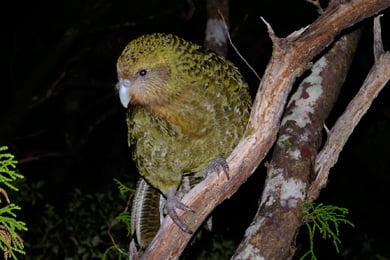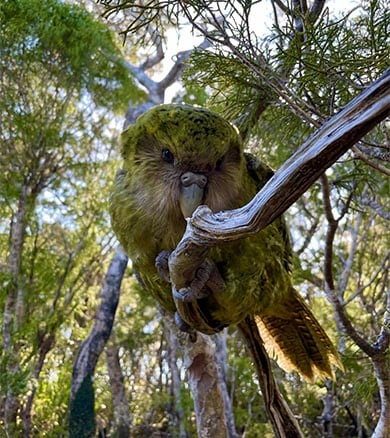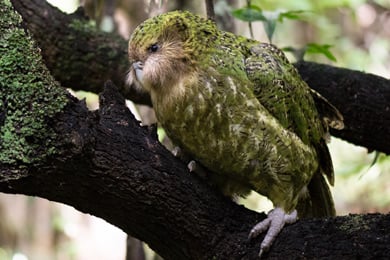How to adopt a kākāpō
1. Choose your adoption type: Email or postage
Email adoptions
Our email adoptions mean no packaging, no postage, minimal carbon footprint and maximum support for your adopted kākāpō.
You’ll receive:
- a personalised certificate by email. You can print and frame it ,or send it as a gift by email
- an email update about your adopted kākāpō
- e-news from the Kākāpō Recovery programme.
Allow up to two weeks for processing of your email adoption.
Note: All adoptions are valid for a 12-month period. They are symbolic, non-exclusive and do not entitle you to ownership of the birds. Postage and email adoptions are non tax-deductible.
Postage adoptions
Postage adoptions are currently closed.
2. Choose your adoption level
There are three levels of adoption to choose from:
- Bronze – $125
- Silver – $250
- Gold – $500
Prices are in New Zealand Dollars.
3. Choose the kākāpō you want to adopt
Who will you adopt? Learn more about the kākāpō you can adopt below and choose your favourite.
You’ll then be taken to our secure online portal to order your adoption.
Bluster-Murphy – Attack survivor

Bluster-Murphy
Image: DOC
Hatched: Whenua Hou/Codfish Island, 28 March 2009
Mother: Fuchsia
Father: Smoko
Named after: The blustery night he hatched on, and the vet who saved his life.
As a chick, Bluster was attacked in his nest by a male kākāpō and lost two toes. He lived to tell the tale thanks to vet Joanne Paul-Murphy. He was given her name in thanks. He is unaffected by the effects of his injury and thrives in the wild.
Bluster-Murphy had a rambunctious teen stage in which he enjoyed stealing other birds’ food and yelling at older males at their bowls. Once rangers set up a food-hopper to catch another male whose transmitter had failed, but Bluster-Murphy was so drawn by the lure of free food that the team ended up catching him multiple times over instead.
Bluster-Murphy is now a young adult and learning well from his elders. He made his first serious attempt at booming during the 2019 breeding season, mated in 2022 and has great potential to become a first-time father next breeding season.
Bluster-Murphy - Email adoption
JEM – Feisty survivor

JEM
Image: Jake Osborne | DOC
Hatched: Whenua Hou/Codfish Island, 29 March 2008
Mother: Aparima
Father: Bill
Named after: The call sign for the trusty Cessna plane that services Whenua Hou.
JEM had an eventful start to life. Her egg was accidentally dragged out of the nest and was exposed to rain for three hours before being taken in to be artificially incubated.
She bred successfully for the first time in 2022 after she mated with Waihopai. She successfully raised her first chick, Āwhina. She has proven to be a great mother and foster mum and is known for laying the first ever recorded clutch of five eggs.
JEM is feisty and has been known to hide when she’s due for her annual health check, often down holes far out of reach.
Marama – Little lady

Marama
Image: Colin Miskelly | DOC
Hatched: Whenua Hou/Codfish Island, 6 March 2002
Mother: Margaret-Maree
Father: Nog
Named after: The Māori word for the moon.
Marama is the smallest and most delicate female in the kākāpō population. She nested for the first time in 2016, and although all her eggs were infertile, she proved to be an excellent foster mum. Because of this, she was given the responsibility of raising Gertrude, a chick with important Fiordland genes. She was calm on her nest, even allowing rangers to check on her eggs and chicks while she was present.
In 2019, Marama successfully produced three of her own chicks and 2022 she was again an excellent foster mum. Marama is a rising star in the kākāpō population with great prospects.
Waikawa – Special starter

Waikawa
Image: DOC
Hatched: Whenua Hou/Codfish Island, 24 March 2011
Mother: Aranga
Father: Blades
Named after: A small coastal settlement regarded as special by local Māori for its rich food and cultural resources.
Waikawa was the first kākāpō to hatch successfully from an egg that was entirely artificially incubated.
In 2016, at age five, she also became the youngest female kākāpō to successfully breed. Sadly, a flash flood destroyed her nest. Only one of her chicks, which had been moved to another nest, survived. This chick was later named Makorea (‘survivor’) in recognition of its lucky escape. In 2019, Waikawa produced the first chick of the season – Kohitātea (January), and four further chicks across two nesting attempts. Her 100 percent egg fertility rate continued in 2022 when Waikawa mated with Te Kingi and laid four fertile eggs. Two hatched (Wai and Kawa), and she was also a great foster mum to Pakiki.
Kumi – Hefty heartthrob

Kumi
Image: Maddy Whittaker | ©
Hatched: Whenua Hou/Codfish Island, 19 March 2005
Mother: Margaret-Maree
Father: Sass
Named after: A Māori word meaning a huge, fabulous monster.
Kumi has always been a big boy. As a chick, he was injured by another kākāpō at just five weeks old, and while receiving veterinary treatment earned the nickname Puku Nui (big belly) due to his size and appetite. In 2019, he was the largest kākāpō on Anchor, topping the scales at 4kg!
At this weight, male kākāpō in breeding condition become almost spherical in shape because of their fat reserves and large ‘boom sack’. Kumi is an excellent boomer and makes an immaculate bowl, and these efforts have been rewarded.
In 2016 he mated with both Waikawa and Kuia, fathering four offspring that year including the first grandchild of the famous Fiordland bird Richard Henry with Kuia. In 2019, he mated with Kōnini three times for over three and a half hours! In the 2022 breeding season, Kumi mated again with Kōnini producing three chicks, Paroro, Avē and Thrum.
Nora – Marvellous matriarch

Nora
Image: Jake Osborne | DOC
First discovered: Rakiura/Stewart Island, 8 July 1980
Named after: Nora of the North Wind, chosen by researcher Margaret Shepard
Nora is the longest known kākāpō alive. She was the first nesting female found on Rakiura, and her capture marked a major turning point in the battle to save kākāpō from extinction.
She hatched three chicks on Rakiura in 1981, including Zephyr who is now a highly productive breeder. Many of Nora’s descendants, including her grandson Sirocco have wind themed names.
Nora was one of the ‘founders’ moved to Whenua Hou/Codfish Island in 1987She has strong maternal instincts. Nora has fostered many chicks over the years. She was once found incubating a kumara/sweet potato!
The 2022 breeding season was Nora’s twelfth. This time round, Nora mated with Tūtoko and famously for 83 minutes with Guapo. Sadly, none of her 2022 eggs developed, but she is a proud mum to Kōtiu and Matangi (2016), and Gale, Kōraki and Rahotu (2019).
Rangi – Artful dodger

Rangi
Image: Jake Osborne | DOC
First discovered: Rakiura/Stewart Island, 4 October 1981
Named after: the Māori word meaning ‘sky’
Rangi is a stealthy bird with exceptional skills at evading the team. He went into hiding after being transferred to Whenua Hou/Codfish Island in 1987 and was only found 21 years later when a ranger heard booming from a bird that didn’t have a transmitter.
Even today, Rangi proves difficult to catch, as he is always alert and runs for the most dense and tangled patches of bush whenever he hears a ranger approach. He can also sneak quietly through the undergrowth to circle back behind rangers that are following him.
Although he hasn’t mated since the programme began in 1995, genetic records show Rangi previously fathered the successful breeders Wendy and Zephyr, among others. As a result, Rangi has the most descendants of any male kākāpō.
Kuia – Genetic genius

Kuia
Image: Theo Thompson | DOC
Hatched: Te Pākeka/Maud Island, 6 March 1998
Mother: Flossie
Father: Richard Henry
Named after: Ngāti Kuia, the iwi for Te Pākeka/Maud Island. Kuia means ‘wise, old woman’.
Kuia is the only daughter of the last Fiordland kākāpō, Richard Henry so she carries precious, rare genetic diversity.
Kuia first bred in 2016 after she mated with Blake and Kumi on Anchor Island. She laid three fertile eggs, but the clutch was removed as she had nested in a poor, sandfly-infested spot. She later mated again with Kumi and laid three more fertile eggs, all which successfully fledged. Her four chicks from 2016 are, Gertrude, Adelaide, Marian and Henry. Kuia successfully bred again in 2019, passing her precious genetics on to Acheron, Quill and McKenzie.
In the 2022 breeding season, Kuia nested but all three of her eggs were infertile. She instead became a foster mum and successfully raised two chicks, Aella and Paroro. During this time, she ate the most food of all the mums on Anchor Island, keeping our volunteers busy.
Rahotu – Future promise

Rahotu
Image: Jake Osborne | DOC
Hatched: Whenua Hou, 22 March 2019
Mother: Nora
Father: Sinbad
Named after: The Māori name for Mitre Peak, in Milford Sound.
Rahotu is a grandson of Richard Henry, the only Fiordland kākāpō to contribute genetics to the existing kākāpō population. Rahotu was fathered by Sinbad with the help of artificial insemination, a tool that the team uses to ensure genetically important and underrepresented males produce offspring.
Rahotu was one of the chicks affected by the fungal respiratory infection, Aspergillosis, during the 2019 breeding season. He was treated by the veterinary team at the Dunedin Wildlife Hospital where he fortunately responded well to treatment, while also picking up a reputation as something of an escape artist.
He has matured into a clever, handsome bird with his father’s beautiful bright green plumage. While busy learning from his elders in the 2022 breeding season, Rahotu lived up to his cheeky reputation. He was frequently spotted making his way around the island raiding the food stations set up for the hardworking nesting mums.
Sinbad – Fiordland father

Sinbad
Image: Jake Osborne | DOC
Hatched: Te Pākeka/Maud Island, 13 March 1998
Mother: Flossie
Father: Richard Henry
Named after: The Sinbad Gully in Fiordland, near where his father Richard Henry was first discovered, and one of the last refuges for kākāpō on the South Island of New Zealand.
Sinbad had a challenging start to life. He was the youngest and smallest of three chicks hatched to Flossie and Richard Henry in 1998. He was removed from his nest to be hand-reared because he wasn’t getting enough food.
While on a plane to the hand rearing facility in Te Anau, he developed respiratory problems, but was saved by a quick-thinking flight attendant who fitted him with a modified oxygen mask.
These days, Sinbad is a curious bird that will often investigate team members and equipment that he finds in his territory. He has immaculate plumage and large eyes, and since 2009 has mated on three occasions, but first achieved fatherhood in 2019 via artificial insemination with Rahotu.
In the 2022 breeding season, Sinbad passed his precious Fiordland genes on to three more chicks by artificial insemination: Madeline with Margaret-Maree, and Kaiako and Tangiwai with Tohu.
Contact
For further enquiries please contact us at kakapoadoptions@doc.govt.nz.
Sign up to our Newsletter or follow us on Facebook or Instagram.
